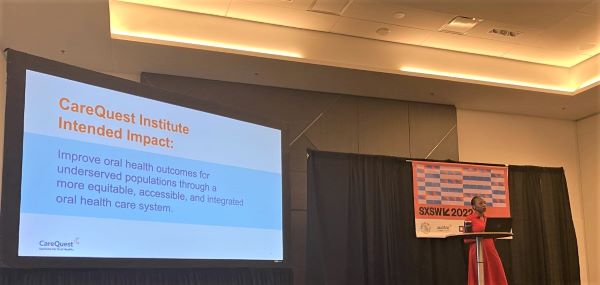Enter your email to receive the CareQuest newsletter:
March 29, 2022
Earlier this month, CareQuest Institute for Oral Health CEO and president Myechia Minter-Jordan, MD, MBA, presented an hour-long session at South by Southwest (SXSW) about the business case for investing in health equity — a topic that has increasingly become a priority across all industries, including health care.
The COVID-19 pandemic drove home the reality that our health care system was built on generations of systemic racism. But it also created opportunities. Attitudes are changing rapidly, government regulations and priorities are changing almost as fast, and we are seeing rapid advances in technology and innovation in health care.
So why aren’t more companies pursuing these opportunities?
The reality is that the business case for investment is rooted in this historic underinvestment in communities of color for generations. This has led to myths and stereotypes about working in underserved communities that only perpetuate the inequities we — as nonprofit leaders, health care leaders, or tech investors — all seek to address.
At SXSW, Myechia set out to bust four common myths about investing in health equity impact — lessons that extend far beyond the business world.

Myth #1: Any investment in BIPOC communities is a good health equity investment.
However well-intentioned, this is a common misconception. When working to lift up BIPOC communities, the first and most important thing to do is to check and double-check your biases. We all have them. To understand how your biases may impact your approach, do your research. Talk to the people most impacted. And do it before you start down the path.
The quote “nothing about me without me,” coined in 1998 and often used to discuss the importance of shared decision-making in health care, fits well here. It’s used when patients and doctors are making medical decisions. Simply put, patients — or employees or communities — should be involved in decisions that directly affect them. It’s a lesson that CareQuest Institute brings to our work in oral health every day.
Myth #2: The Medicaid population isn’t a viable market.
One barrier to investments, particularly in Medicaid populations, is the notion that underserved communities are too challenging and complex. Any investment, the thinking goes, is philanthropic and provides little true business value. But that is absolutely not the case.
Take the expansion of services covered within Medicaid. Particularly during the pandemic, states have begun to understand that expanding covered services is another way to reduce disparities in health care. For example:
- Since the American Rescue Plan passed in March, 19 states have expanded pregnancy coverage under Medicaid to help address the Black maternal health crisis.
- And seven states have expanded to include preventive dental coverage in order to reduce health costs and better address chronic illnesses.
The expansion of dental care under Medicaid to increase access to care will offer opportunities for nonprofit and for-profit organizations across the health care spectrum.
Myth #3: Health Equity “investments” aren’t sustainable or scalable.
Many people worry that developing solutions specifically focused on underserved communities isn’t sustainable or scalable from a business perspective. But the reality is that communities that are chronically underserved by our current models are often the best place to start, especially in health care.
Cityblock Health, a company dedicated to improving care for Medicaid populations, is proving this point. Cityblock Health now has a valuation of over $5.7 billion — and continues to grow.
Myth #4: Government and regulations kill opportunity.
Understandably, the idea of working with a population that is entirely dependent on government programs that are heavily regulated can give people a headache. Anyone who works in the nonprofit space knows this reality. However, we’ve also seen that regulations in health care right now are changing at a relatively rapid pace, especially as government has been forced to adjust to the new reality of the pandemic.
Teledentistry is a perfect example. In many states, at the start of the pandemic, it wasn’t even legal. But that is quickly changing. In June 2021, the Texas legislature passed a law allowing teledentistry, and many more states are following suit. Organizations like CareQuest Institute are also helping make it happen through funding and capacity-building activities within community organizations and advocacy. We’re working with the Texas Health Institute, which, since the law passed, has used grant funds to ensure that the community and consumer voice is involved in the design and early-stage implementation of the new law.
Telehealth, and teledentistry in particular, is an area that is ripe for innovation and opportunity. And direct involvement of community-based organizations will ensure those advancements successfully help those who need it the most.